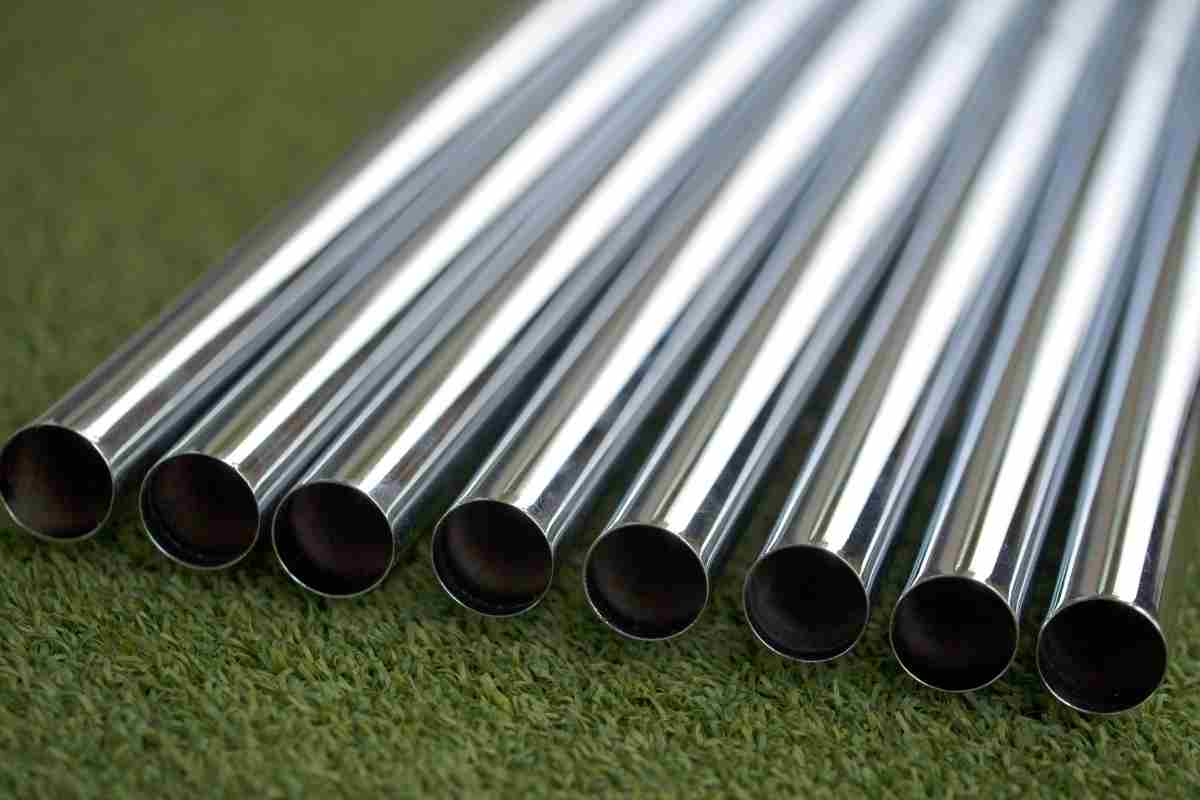Golfers no longer need to pick out the best golf club head for their game; they also need to focus on the shaft that will suit them best. Golf shaft technology has changed through the years, and there are more options now than ever.
The easiest way to start breaking down which shaft is better for your game is to look at graphite vs. steel. Graphite and steel shafts have some great features; this is not a matter of one being better than another. The key is determining which is right for you.
Let’s look at the best way to tell whether the graphite or the steel shaft is the solution for your golf game.
What Is The Difference Between Graphite and Steel Shafts?
The major difference between graphite and steel shafts is their composition.
Graphite golf shafts are made with composite shafts built to be lighter.
Steel shafts are stable, sturdy, and workable.
The composition of these golf shafts will lead to different performance attributes. Understanding how they perform can make your decision about which golf shaft you need much easier.
| Graphite Shaft | Steel Shaft | |
| Flexibility | Most Flexible | Moderate Flexibility |
| Vibration at Impact | Dampened | Average |
| Swing Speed | Fast | Average |
| Distance Technology | Long distance | Average |
| Accuracy | Average | Excellent |
| Durability/Longevity | Average | Excellent |
| Affordability | Expensive | Average |
| Workability/Control | Average | Excellent |
How Are Steel And Graphite Shafts Different?
Aside from the difference in cost that you see when you purchase a steel or graphite shaft, there are performance differences that will impact your game. Let’s remember that in the game of golf, there are no magic solutions. Switching to a graphite shaft will not turn a 15 handicap into a scratch golfer.
However, there could certainly be a few shots difference here that changes the way you play.
Let’s look at a few categories where the graphite and steel shafts will differ.
Shaft Weight
Typically speaking, graphite shafts are lighter than steel shafts.
Some new steel shafts on the market will rival the graphite when it comes to speed, but for the most part, if you need a lightweight golf shaft, you will want to go with graphite.
Lightweight golf shafts help with speed. With the graphite shafts being a bit easier to swing, you can gain extra speed and hit the ball a bit harder.
One great thing about graphite shafts is that you can also get them in heavier weights. Even though most golfers assume that steel golf shafts will be the only heavy choice on the market, this is not the case. More companies are starting to release graphite shafts that are heavy and help the faster-swinging players.
Ball Flight
The ball flight of your golf shot will be impacted by the type of golf shaft you use. Graphite shafts allow for a higher ball flight, whereas steel shafts create a slightly lower, more controlled flight.
It’s great to hit the ball high; a higher launch typically leads to more carry and longer shots. The only problem with the higher ball flight is that it can be challenging to control.
When the vertical launch is a bit too high, you can start to lose both distance and control. However, ball flight is not easy for all players. Beginners and slower swing speeds sometimes can’t get the ball off the ground, and the graphite shaft helps improve that.
Shaft Flex
Both graphite and steel golf shafts are offered in a variety of flexes. At the real stiff end of the spectrum, you will see the extra stiff shaft, and the senior and lady’s shafts will be on the more flexible side of things.
The complicated thing about golf club flex is that it can vary from manufacturer to manufacturer. A Fujikura Stiff shaft may be slightly different than a True Temper stiff. This is partly why custom club fitting has gotten so much more popular.
Generally, a regular steel shaft will play a little stiffer than a regular graphite shaft. Part of this involves other factors like weight and kick point. However, don’t be surprised if you change flexes when you move from graphite to a steel golf shaft.
The flex of the club that you play should directly correspond to your swing speed. The faster you swing the club, the stiffer the golf shaft you should play.
Related: What Shaft Flex Should You Be Playing? It may surprise you
Pricing
Steel golf shafts are cheaper than graphite. The manufacturing process for a steel shaft is considerably easier and makes it so that the price can stay lower. Graphite shafts not only require more time spent working on the shaft, but they also need materials that can be harder and more expensive to obtain.
Try not to choose the golf clubs for you based on price alone, although we know that is not always possible.
Durability/Longevity
Steel golf shafts are more durable and hold up longer than graphite shafts. Golfers that travel a lot or tend to be rough on their equipment prefer steel shafts to graphite shafts.
Should I Play Graphite or Steel Shafts?
Now that you understand the differences between graphite and steel golf shafts let’s look at which one will be the best for your game. Certain golfers will fit into the graphite and steel category very clearly.
If you are not one of those players, there is always an option of doing a mixed set. Having graphite shafts in your long irons and steel in your wedges is acceptable. A custom golf fitting can help you figure this out.
Who Should Play Graphite Shafts?
Golfers that play graphite shafts typically do it to get extra ball speed. However, there are other reasons to think about using graphite shafts. Here are a few of the players that fit in this category the best.
- Golfers with slower swing speeds
- High handicappers and beginners that need more forgiveness
- Players that struggle with launching their golf shots
- Junior golfers and many women golfers
- Those with arthritis who struggle with vibration at impact
- Golfers seeking distance
- Any player that feels fatigued at the end of the round
Who Should Play Steel Shafts?
Steel shafts tend to be more popular among lower-handicap golfers with faster swing speeds. The steel shaft allows for quite a bit of control and precision in the shots that are hit. Here are some of the players that will benefit most from using steel shafts in their golf clubs.
- Physically strong golfers and athletes
- Players with lots of club head speed
- Better players who want more feel and feedback in their swing
- The golfers that like to work the ball left and right
- Players that want to control the ball flight and launch
- Precision and accuracy are preferred over distance
- Golfers that have a hard time controlling the spin and direction of their golf shots
Graphite vs. Steel Shafts In Relation to Handicap
When you look at our recommendations for who should play graphite or steel golf shafts, you can see that handicap comes into the discussion often. It is often understood that higher handicappers and beginners should be using graphite while lower handicappers use steel. This is not the case.
Low Handicap
Lower handicap players and professionals often have steel shafts in their irons and wedges. However, with companies creating shafts like the SteelFiber, they realize that there are some great benefits to graphite.
If you struggle with distance in the long irons, it can make sense to put a graphite shaft in place to improve the launch and total distance.
Mid Handicap
Mid handicap golfers should choose their golf shaft based on performance and not handicap. The mid handicappers tend to be split down the middle when looking at who uses graphite and who uses steel.
Look at steel if you are a bit wild on the course and need some consistency.

High Handicap & Beginner
There is a misconception in the world of golf that all beginners and high handicappers need to use graphite golf shafts. This is not true.
Many beginner golf sets have graphite shafts to help golfers get more forgiveness, extra club head speed, and easier launch. However, this does not mean that graphite shafts are the best option for all golfers.
If you have a fast swing speed and no issues with the launch, the graphite shaft could make it harder to control golf shots.
In the case of an athletic high swing speed beginner golfer, those beginner graphite sets can actually be detrimental to the game. Too much spin is created, causing major issues in performance.
Do All My Golf Clubs Need To Be Graphite?
Throughout this guide, we have talked about graphite and steel shafts across an entire set of clubs. However, most golfers have a mix of both graphite and steel in their golf club sets..
Woods
All woods should be graphite shafts. Fastening swinging players can go with heavier graphite shafts, but they still should be graphite shafts. We have done enough testing in golf technology to know that graphite shafts in the longer clubs help increase performance considerably.
Irons
Irons can be both graphite and steel, and it does not matter if you mix graphite woods and steel irons. With Irons making up the majority of your set, be careful about your decision. More and more players are moving to steel in the lower irons and wedges but keeping long irons graphite.
Wedges
The wedges are where people tend to make mistakes related to golf shafts. If you have a complete set of graphite shafted irons and your wedges switch to the heavy wedge flex stock steel shafts, you may have a bit of a disconnect in your golf club set.
For the most part, if you swing with graphite shafts in your irons, you will want to put graphite shafts in your wedges.
You will want control when you swing a wedge, which is why so many people stick with steel. However, to get out of a bunker or put spin on a shot, you also need a good amount of clubhead speed. Graphite is a better choice if the steel shafted club shaft makes that too difficult.
Putters
Most golf putters are sold with steel shafts. Odyssey released their entire line of Stroke Lab putters with a shaft that is partly graphite and partly steel. This is a unique addition to golf equipment and the first time we have seen putter shafts explored this way.
In the past, the putter club head, face insert, and grip were all that mattered, but the addition of the Stroke Lab putters to the market has made many wonder if the putter shaft is just as important as the others.
For the most part, if your putter is steel, you don’t need to run out and get a graphite shaft. Think about the different shaft options you have the next time you replace your putter.
Do Pro Golfers Use Graphite Shafts?
Pro golfers use graphite shafts in the drivers, wood, hybrids, and sometimes even their long irons. Most of the players on the PGA Tour have so much swing speed and require feedback from their iron shafts that only steel will provide.
A few have experimented with graphite shafted irons for a while, but steel ends up being the golf shaft of choice for the most part. Keep an eye out on the PGA Tour golfers; as technology in graphite improves from a control standpoint, you will see more players switching.
Conclusion: What Is Better, Graphite or Steel?
In the end, I can’t say that graphite or steel shafts are better. Instead, a combination of options in your bag that works specifically for your swing speed and ball flight preferences is essential.
Getting a golf shaft that is custom to your golf swing capabilities, strengths and weaknesses is more accessible than it ever has been. Most importantly, knowing the differences between graphite and steel makes you much more equipped for this purchasing decision.




